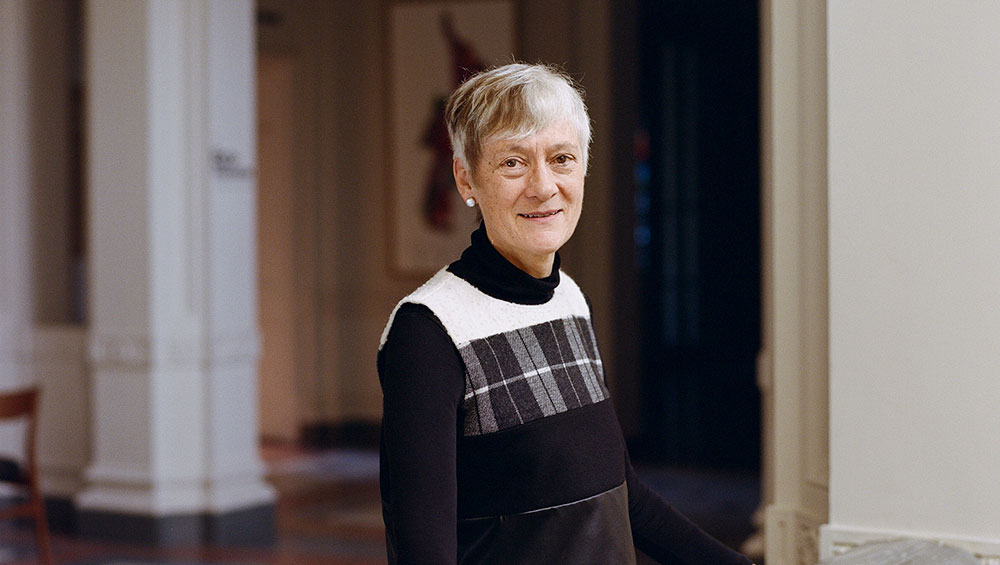
Rebecca Salter, portrait © Jooney Woodward.
by DAVID TRIGG
While her art school peers were looking to London and New York, Rebecca Salter (b1955, Sussex) had her sights set on Japan, a country that has had a profound influence on her work. Travelling to Kyoto on a scholarship in 1979, she spent six years immersed in Japan’s art and culture, learning traditional techniques such as the ancient art of woodblock printing. Over four decades, her ethereal, non-figurative paintings, drawings and prints have built on this formative experience. Embracing eastern and western traditions, they show the influence of mid-century minimalism as much as Japanese aesthetic restraint. As Salter has remarked, they represent an attempt to “finesse the bridging of the two cultures”.
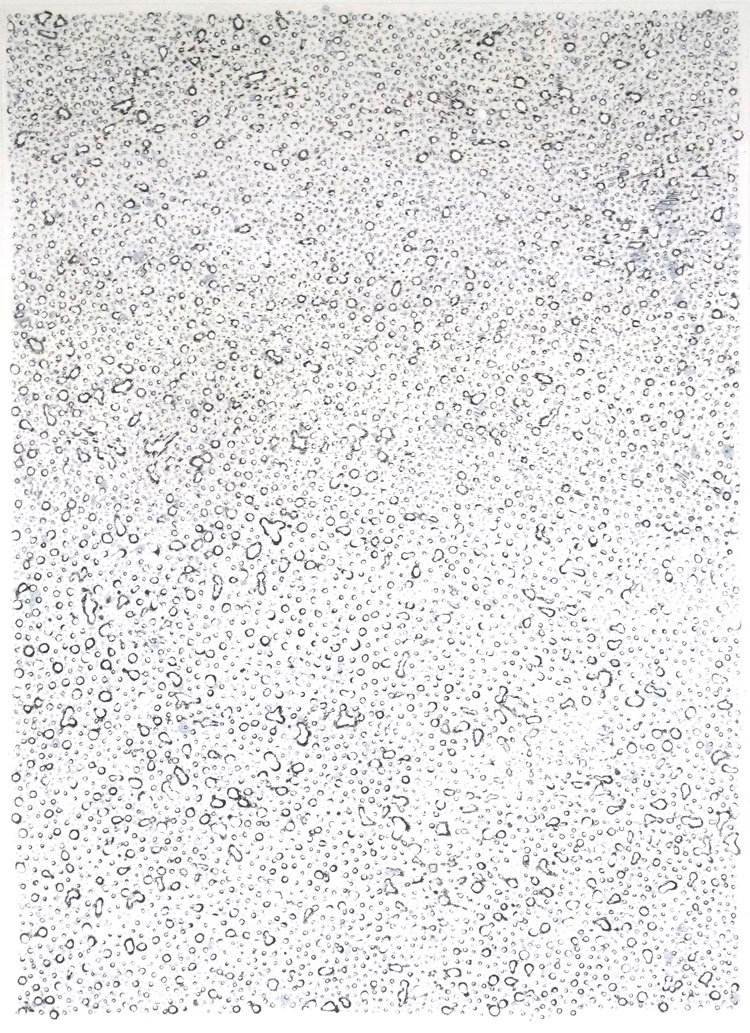
Rebecca Salter, 2020-15, 2020. Mixed media on paper, 74 x 54 cm (29 x 21 in). © the artist.
Especially important to Salter is the Japanese concept of shibui (literally “astringent”), which refers to an aesthetic sense of unobtrusive beauty that balances simplicity with complexity. This is reflected in her muted palette and the simple yet laborious mark-making techniques she employs. Her distinctive drawings, for instance, are formed from small, repeated marks made with a variety of tools, including a heat pen, which scorches the paper’s surface. Some are made with clouds of tiny ink spots, while others comprise thousands of puncture marks – a technique that serves to emphasise the work’s status as a three-dimensional object. Her use of thick Japanese papers allows pigment to be absorbed, causing image and substrate to fuse into single objects. Salter uses this technique in her works on canvas, too, soaking her linen with water and allowing her paint to bleed into the fabric.
In 2014, Salter was elected as a Royal Academician to the category of Printmaker. Three years later, she was elected Keeper of the Royal Academy, with the responsibility of guiding the RA Schools. In December 2019, in an historic vote, she became the 27th President of the Royal Academy of Arts and the first female president since the Academy was founded in 1768. However, her tenure has been overshadowed by the coronavirus pandemic. In this interview, Salter speaks to Studio International about the influence of Japan on her work, the challenges of leading the Royal Academy through the lockdown and the impact that this has had on her practice.
David Trigg: After graduating from Bristol Polytechnic in 1977, you travelled to Japan on a Leverhulme fellowship to study at Kyoto City University of the Arts. What attracted you to the country?
Rebecca Salter: There is something about the Japanese way of viewing the world that I find endlessly rich and fascinating. When I think back, it was quite an eccentric decision to make because all my contemporaries wanted to go to New York; nobody wanted to go east. I’d always been interested in Japanese art and aesthetics, but I became obsessed as a student. In those days, it was unbelievably difficult to organise a trip like that. We didn’t have the internet, so you couldn’t just Google Japanese art schools; it took two years to secure my place at Kyoto City University of Arts.
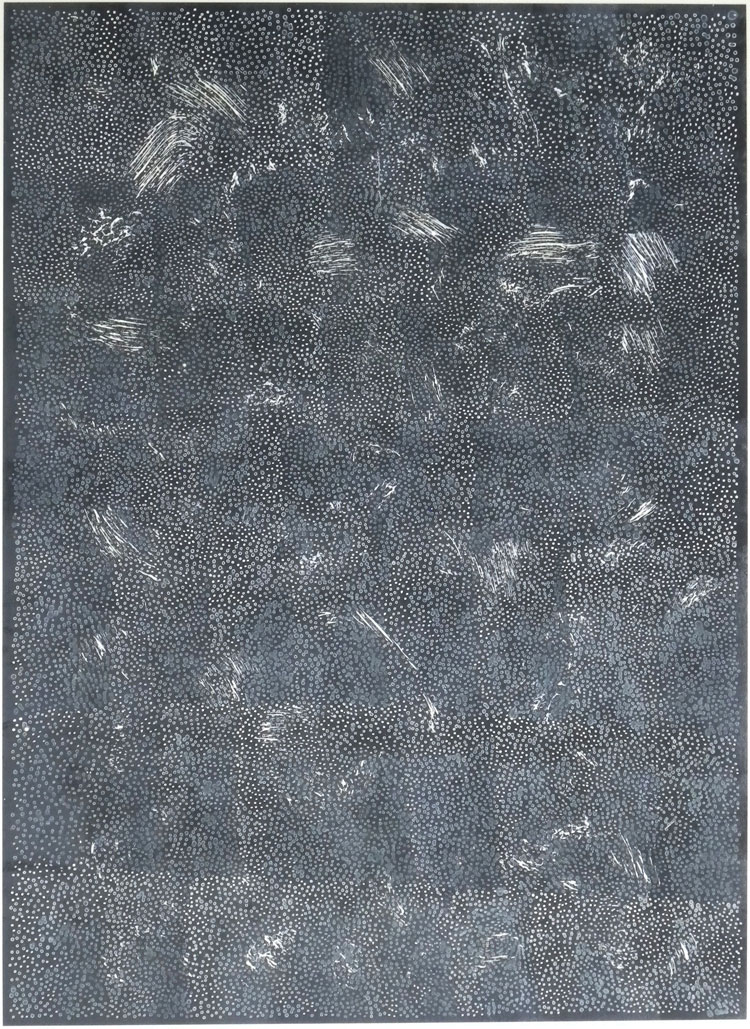
Rebecca Salter, 2020-21, 2020. Mixed media on paper, 74 x 54 cm (29 x 21 in). © the artist.
DT: How did the education you received in Japan differ from that at western art schools?
RS: Japanese art schools grew from grafting a craft tradition and traditional way of learning based around apprenticeships on to a western model of art schools. I remember there was a class where the students were learning to become copyists of historic Japanese paintings, which is hard to imagine happening in an art school here. The most extraordinary thing of all is that the painting department was divided into western painting, where you used oil paint and canvas and perspective, and eastern painting, where you used paper and pigment and it was all water based. The two activities ran in parallel and there was little crossover.
DT: What techniques did you learn in Kyoto?
RS: I’d studied ceramics in Bristol, so my scholarship was to continue with that in Japan, but, by the time I got there, I had realised that ceramics was not for me. I was fed up with vessels and I didn’t like the fact that you needed kilns and all that technical kit. Then there was the risk that, after you’d done all this work, you’d put it in the kiln and it might crack or fall over. I thought, innocently, that I’d be able to move from one department to another in the art school, but they said no. So, I was stuck nominally studying ceramics for two years. The most important thing I did during that time was to learn the language, which gave me access to what I really was interested in, which was finding out more about paper, pigment and painting.
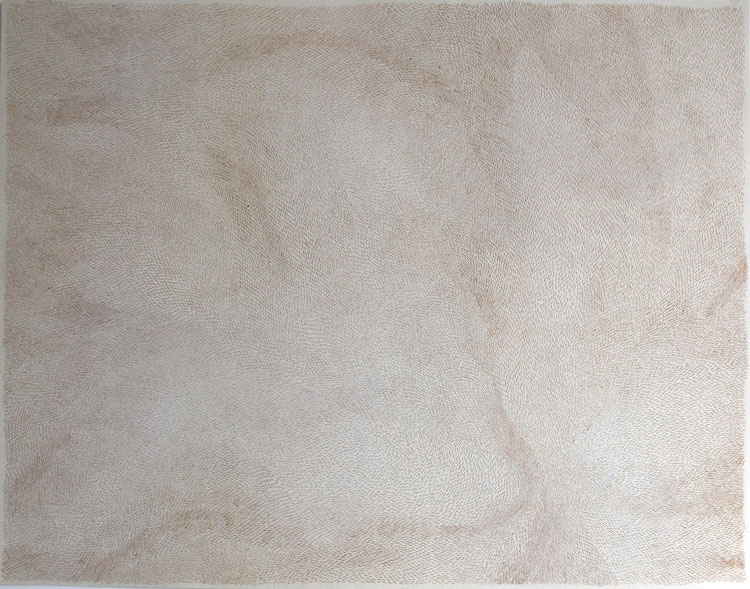
Rebecca Salter, Untitled AG48 (2014), pyrography on kozo paper, 94 x 120 cm (37 x 47 in). © the artist.
DT: Your training in Japanese woodblock printing came after your time at the university?
RS: Yes. Again, in my innocence, I thought the printmaking department in the art school would teach me how to do woodblock but they only did etching and lithography. There’s this peculiar quirk in Japan whereby they tend to devalue their own traditions. We are fascinated by them in the west, but, even now, it’s almost impossible to learn Japanese woodblock in any university in Japan. In the end, I found a professor, Kurosaki Akira, who was a woodblock print artist. He had worked in the workshops of the traditional carvers and printers, then he’d amalgamated the two activities, started producing his own work and was teaching it. I went on one of his summer courses.
DT: What was it like returning to England after six years in Kyoto?
RS: I had gone to Japan aged 24 and come back aged 30. In that time, a lot had happened to my contemporaries: they’d bought houses, got married and found jobs. I arrived back having had this extraordinarily rich experience, but having to start from scratch again, which was tough. Thinking back, the real root of the struggle was that I had become obsessed with not only Japanese aesthetics but also the country’s architectural space. Coming back was a culture shock – I couldn’t face going to the National Gallery because I couldn’t bear the surface of oil paintings, they were so shiny that they kind of shut you out. I found stone buildings the same because in Japan space is not as defined as it is here, it’s much more fluid.
DT: Japanese aesthetic principles are still very important to your work. Can you explain the role they play?
RS: It’s largely about the way I imagine the picture plane and the way that whatever I’ve got on the surface meets the physical edge of the painting. In the west, the viewer is traditionally placed firmly in front of the painting, and you have perspective leading you in. The eastern perspective uses your peripheral vision much more, so the edges of the work are crucial. As a viewer, you enter the work and explore it in a way that you don’t do with a traditional western painting. Also, the physicality of the materials is important. In western art, the surfaces are non-absorbent; there’s a substrate to which you apply paint and it’s almost like the paint contains the meaning. In the east, the substrate is absorbent and it’s as if the paint and the substrate become an object.
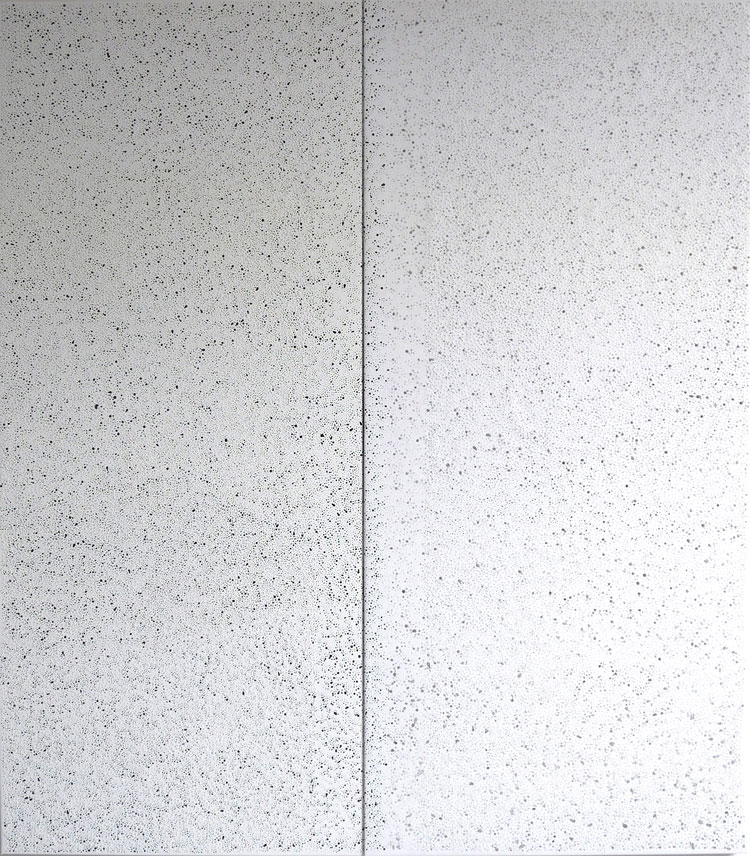
Rebecca Salter, Untitled AR4, 2019. Mixed media on linen, 200 x 175 cm (79 x 69 in). © the artist.
DT: Rather than painting on to a surface, you are painting into a surface.
RS: Yes, and I think of my paintings as 3D objects, so I spend quite a lot of time thinking about how deep the stretcher is, what I do to the surface of the painting and other physical aspects of the work. I think you could trace that back to my background in ceramics and working in three dimensions.
DT: Is that the same for your drawings?
RS: Yes, all the papers I use are really heavy printmaking papers. I saturate them with water and then allow them to dry before saturating them again. In Japan, I worked exclusively on Japanese paper, which is highly absorbent. At the moment, I’m using Japanese paper laminated on to western paper, but the kind of paper I use depends on how much I’m punishing it.
DT: Repetitive mark-making is central to your drawing practice. What tools do you use?
RS: Apart from a dip pen, I mostly use found objects, such as a sharpened chopstick or something I’ve found in a pound shop, weird things that make marks. I hardly ever use a standard brush or pencil – it’s all very improvised. It’s about keeping the line alive by interrupting your skills; if you’re using some weird implement, you are less skilful with it than perhaps you would be with a proper tool, and that gives you a feeling of being slightly on the edge.
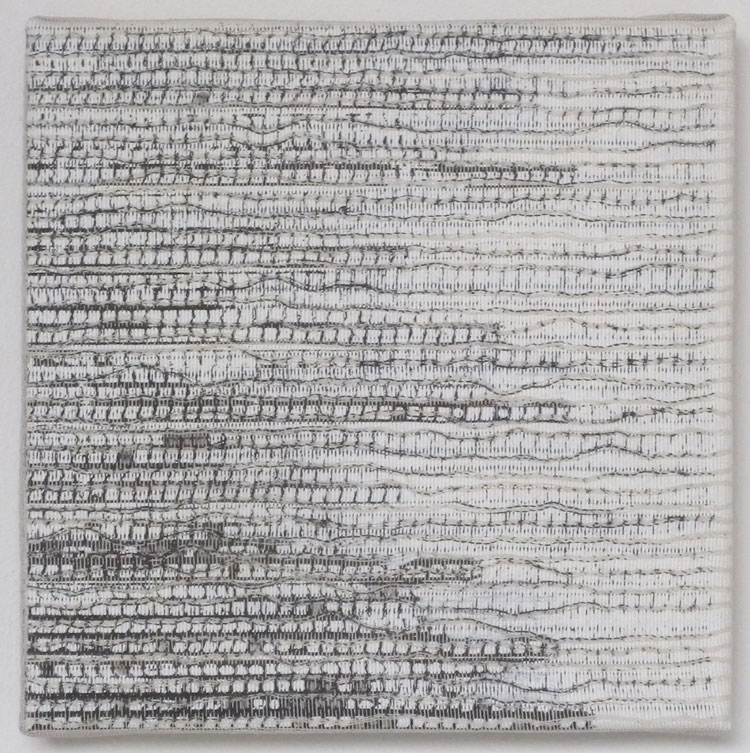
Rebecca Salter, Untitled AR12, 2019. Mixed media on muslin on linen, 15 x 15 cm (6 x 6 in). © the artist.
DT: How did you start working with pyrography?
RS: I just decided one day to buy one of those wood-burning tools, to see what would happen if I used it on paper. It’s a bit like a soldering iron, you plug it in and there are various tips that you can put on it. The burn marks change depending on how quickly they are made, so you have to use it with a certain rhythm.
DT: Do you work intuitively, or do you have a preconceived idea about the kind of image you want to make?
RS: I work intuitively, but I have periods of research and development where I experiment with various materials, messing around with them to see what happens. Then, if something interesting emerges, I’ll experiment further on paper until I’m comfortable with transferring it to linen, which is what I mostly use for my paintings.
DT: Your approach is quite precarious, leaving little room for error. Do you reject many works?
RS: Sometimes they go badly wrong, but then I usually do something drastic, like pouring a bucket of water over them, which will lead me off down a different path. I’ve got a bit of a history of destroying work – I threw my Bristol degree show into the River Avon as I was leaving Bristol, and all the work I’d made while living in Japan, which I’d stored in a lean-to, got destroyed in a typhoon. But I have this streak in me that just says: “Oh well, let’s start again.”
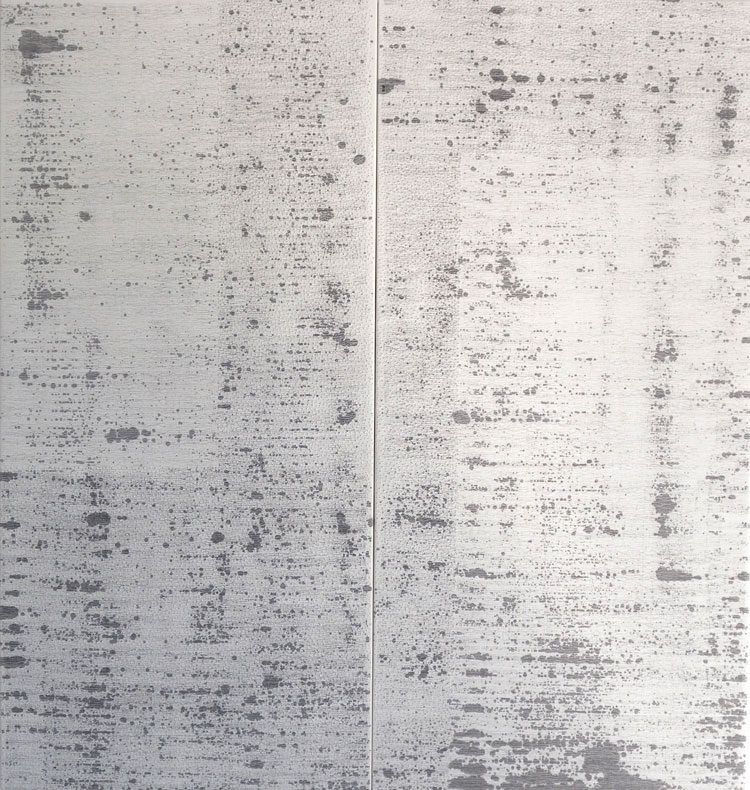
Rebecca Salter, Untitled JA9, 2020. Mixed media on muslin on linen, 160 x 150 cm (63 x 59 in). © the artist.
DT: How did you begin working on canvas?
RS: At some point I went on holiday to the Lake District with a friend and the landscape just unlocked something for me. I’d taken a sketchbook with me and I realised after a while that I was interested in the speed of the weather and what it was doing to the landscape. I did a lot of very quick drawings and then went back to the studio, made a big drawing, cut it up into squares, moved them around and stuck them back together again. It was a method of fragmenting the line and redrawing, which I could do really easily on paper. Then I wondered what would happen if I tried it with canvas. Of course, with canvas I had to deal with the fact that it’s woven, so I had to stabilise it first to prevent it from falling apart. Again, it all became very structural. The biggest one I did of those was six feet x nine feet (1.8 metres x 2.4 metres), which is an awful lot of one-inch squares that I had to cut and glue back down again. But people thought I was either obsessed with the grid – which I’m not – or they were obsessed with how I had the patience to do it, which was not very interesting, so I stopped doing them.
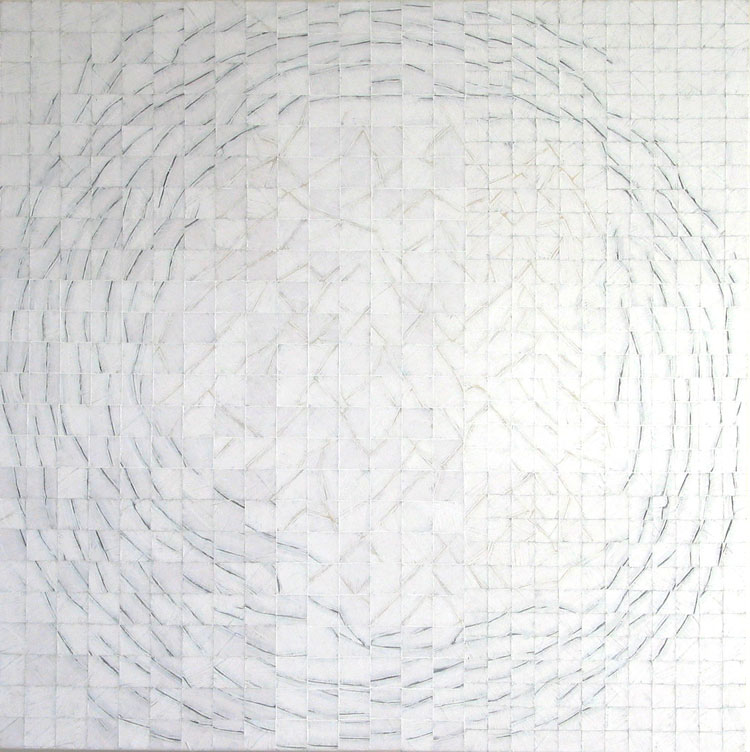
Rebecca Salter, Untitled G15, 1991. Mixed media on canvas, 122 x 122 cm (48 x 48 in). © the artist.
DT: You regularly visit the Lake District to draw. How does the place feed into your works?
RS: I’ve been going there every year, to the same place, for 13 years. It doesn’t feed into my work directly, but it’s a sort of refreshment and it energises what I’m doing in the studio. I’m very familiar with the landscape now, it’s like meeting a really old friend and each time I start where I left off. But I don’t keep the sketchbooks in the studio: in fact, I never look at them again.
DT: In December 2019, you were elected as the first female president of the Royal Academy of Arts (RA). What was your reaction on hearing the news?
RS: I was shocked because I’ve never done anything like this before. I’ve been sitting on my own in a studio for the last 30 years, so it is a huge honour and a great responsibility. But then there was the realisation that, whenever a woman does anything for the first time, the pressure is doubled because if you screw up, the critics will say it is because you’re a woman. It’s sad, but it’s true. Now, thanks to the pandemic, I’m also the unluckiest RA president in history!
-Fraser-Marr.jpg)
Façade of Burlington House, Royal Academy of Arts, London. © Fraser Marr.
DT: How long is the presidency and what are your key responsibilities?
RS: The terms of office for the Keeper and the Treasurer are three years and they can be re-elected to a maximum of nine years. The president can serve a maximum of 10 years but has to stand for re-election every December. I work very closely with the secretary and chief executive, Axel Rüger, who, with the executive team, has responsibility for operations and staff; it’s my job to represent the interests of the Academicians and to represent the RA publicly. As president, I also chair Council, which is like the board of the RA. It normally meets nine times a year but, when the pandemic hit last year, we began meeting weekly and then fortnightly; this year, we’ve been meeting every three weeks, so I’ve now chaired as many Councils as if I’d been president for four years.
DT: Your presidency has been overshadowed by the pandemic, which arrived in the UK a few weeks after you took up the role. What has been the biggest challenge?
RS: The RA has had its fair share of crises in its 253-year history, including two world wars, but this has been the biggest crisis we have ever experienced. I’d only been in office for about 12 weeks when the pandemic arrived. The minute we shut the doors, we started losing money. At the start of the first lockdown, we were losing £1m ($1.36m) a month. We furloughed as many people as we could, but the organisation still had to be run even though it wasn’t open to the public. We have had to reduce every cost and reconsider every aspect of what we do in order to keep our head above water. We had to cut our operational budget and, sadly, we had to lose around 100 staff roles. People think we’re rich because we’re in Piccadilly and have the word “royal” written over the door, but we don’t get any government money. We have to raise every penny.
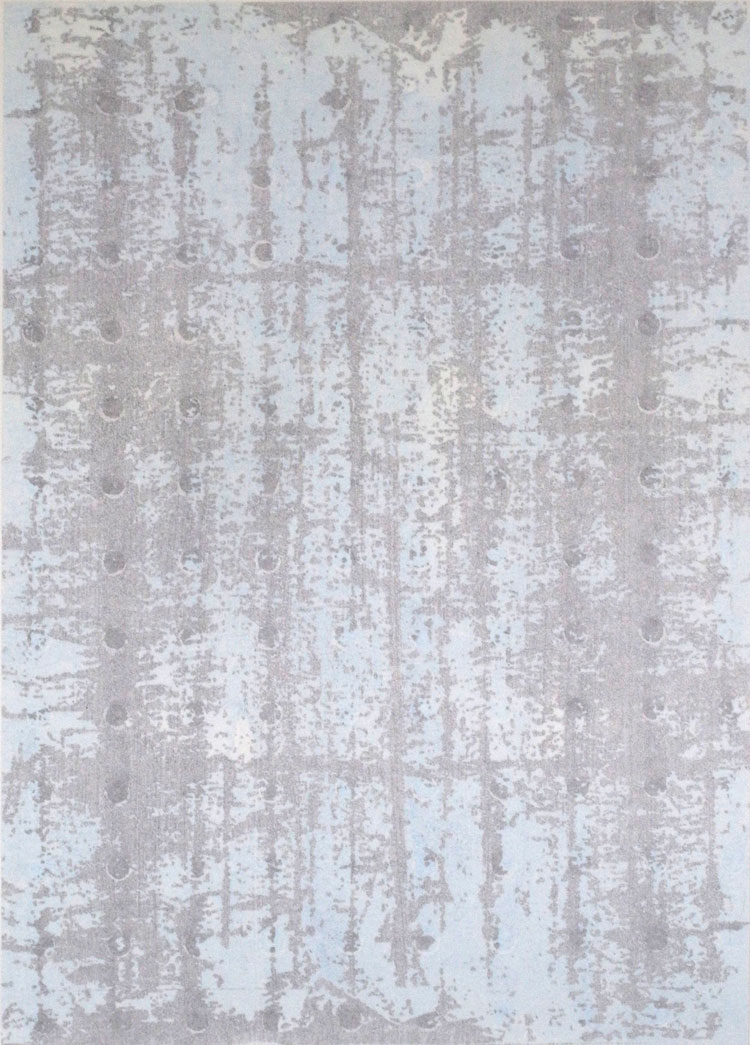
Rebecca Salter, Selva, 2020. Japanese woodblock, 35 x 25 cm (14 x 10 in). © the artist.
DT: What other challenges were there besides the financial losses?
RS: We have not been able to elect any new academicians because of the RA’s laws; they date back to 1768 and stipulate that we must all be physically in a room to vote. Also, the world of international art exhibitions is all joined up. Exhibitions that we had been planning to show, such as Angelica Kauffman, got stuck in Düsseldorf, and our Picasso and Paper exhibition stayed with us in London. Then, of course, we had to renegotiate all the loans, so it was like a big game of musical chairs. The constant uncertainty about reopening to the public made it very hard to plan the programme and I’m not sure the complex logistical difficulties of putting on exhibitions are fully understood by the government.
DT: It was remarkable that the 2020 Summer Exhibition went ahead, albeit in the winter. Were you tempted to cancel?
RS: No, the Summer Exhibition has never been cancelled. It ran all the way through the world wars, so we were absolutely determined that we weren’t going to be the first team to cancel it. The exhibition is part of an ecology. For many artists, including Academicians, selling work at the summer exhibition is a vital source of income. Beyond that, you have the picture-framers who frame the works and the van drivers who deliver them, so it was important that we were able to offer some form of support for people working in the broader artistic community. By a stroke of luck, we had completed the first round of selection in early March 2020, so we set about shifting the exhibition to later in the year.
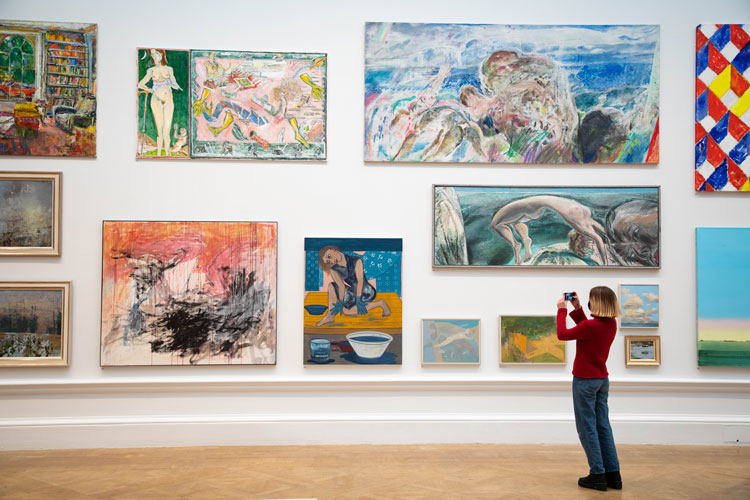
Installation view of Summer Exhibition 2020, Royal Academy of Arts, London. Photo: David Parry / © Royal Academy of Arts.
DT: How do you juggle your responsibilities at the RA with your own practice?
RS: My job is meant to be two to three days a week. My predecessor, Christopher Le Brun, worked Monday to Wednesday at the RA and his one word of advice to me was that I must absolutely stick to that. Of course, with the pandemic that’s completely gone out of the window, and I’ve been working seven days a week at times. During the first lockdown, we had a crisis meeting on Zoom nearly every morning, but it was almost impossible to make any decisions; we would decide something and that decision often needed to be changed by lunchtime. I’ve been doing everything on Zoom from my studio, but what’s beginning to wear me down is the fact that I haven’t had enough mental space for my own practice. Making work has become harder and harder and I may find that I emerge from this having paid a career price for spending so much time on the RA.
DT: How is the RA reinventing itself as it emerges from the pandemic?
RS: The RA has had to reinvent itself many times in the past and now we are doing it once more. What has become very clear is the need to focus again on our core activities – our world-class exhibition programme, the Royal Academy Schools, our rich collection and our learning programme. Before the pandemic, arts institutions had become machines of endless growth. We’re not in a time of growth now, but the show has to go on; we’ve just got to consolidate and find a model that works. I believe that art thrives in a crisis and this can be a cause for hope.